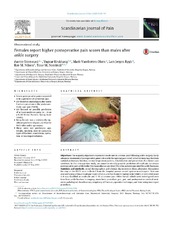| dc.description.abstract | Objectives: The majority of patients experience moderate-to-intense pain following ankle surgery. Early, adequate treatment of postoperative pain is desirable for optimal pain relief, which in turn may facilitate optimal pulmonary function, normal respiration pattern, rehabilitation and prevention of a chronic pain condition. In this retrospective study, we aimed to identify possible predictors of moderate-to-intense postoperative pain while in the Post Anaesthesia Care Unit (PACU) in patients operated for ankle fractures. Materials and methods: Social demographics and clinical characteristics from admission throughout the stay in the PACU were collected from the hospital patient record system in retrospect. Pain was assessed using a Visual Analogue Scale (VAS) or a verbal Numeric Rating Scale (vNRS). A VAS/vNRS score 4–6 was classified as moderate and 7–10 as intense pain. Other factors which were investigated were time from ankle fracture to surgery, anaesthetic procedure, pre-, per- and postoperative medical treatment, radiological classification, complexity of fracture, operative technique, and time using tourniquet procedure. Results: Data from 336 patients who underwent surgery to repair an ankle fracture between January 2009 and December 2010 were analysed. None of the following variables had a statistically significant effect on pain; age, weight, smoking, timeframe from fracture to operation, type of anaesthesia, opioids given peroperatively, complexity of the fracture, operation technique or tourniquet inflation procedure. Female sex predicted moderate-to-intense postoperative pain in the PACU with odds ratio 2.31 (95% confidence interval 1.39–3.86), P = 0.001. As far as we know, this is the first study to show a sex difference in reporting pain in the first hours after surgery for ankle fracture. Conclusion: Female patients operated for ankle fracture report higher pain-intensity-score than male patients while in the PACU. Implications: Our findings suggest that treatment strategies to prevent high peaks of pain should particularly target women operated for an ankle fracture. | en_US |

